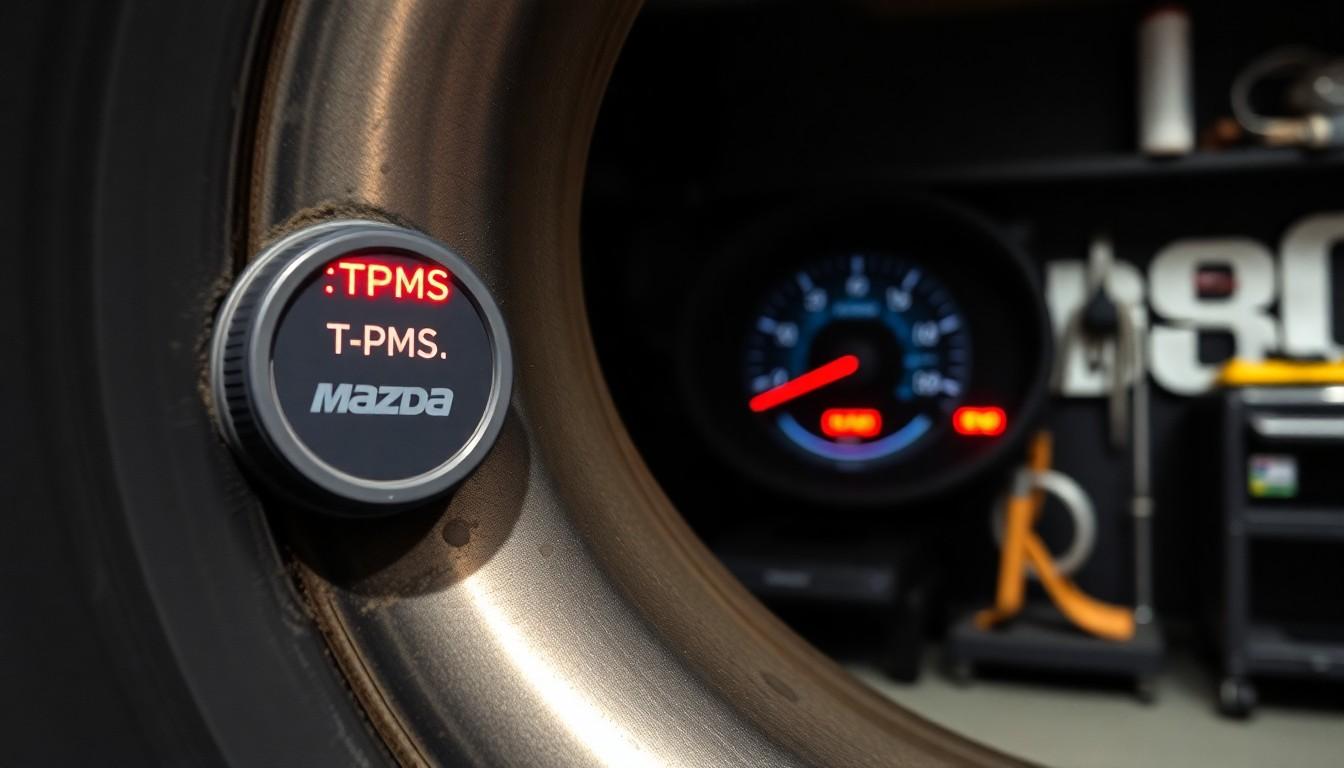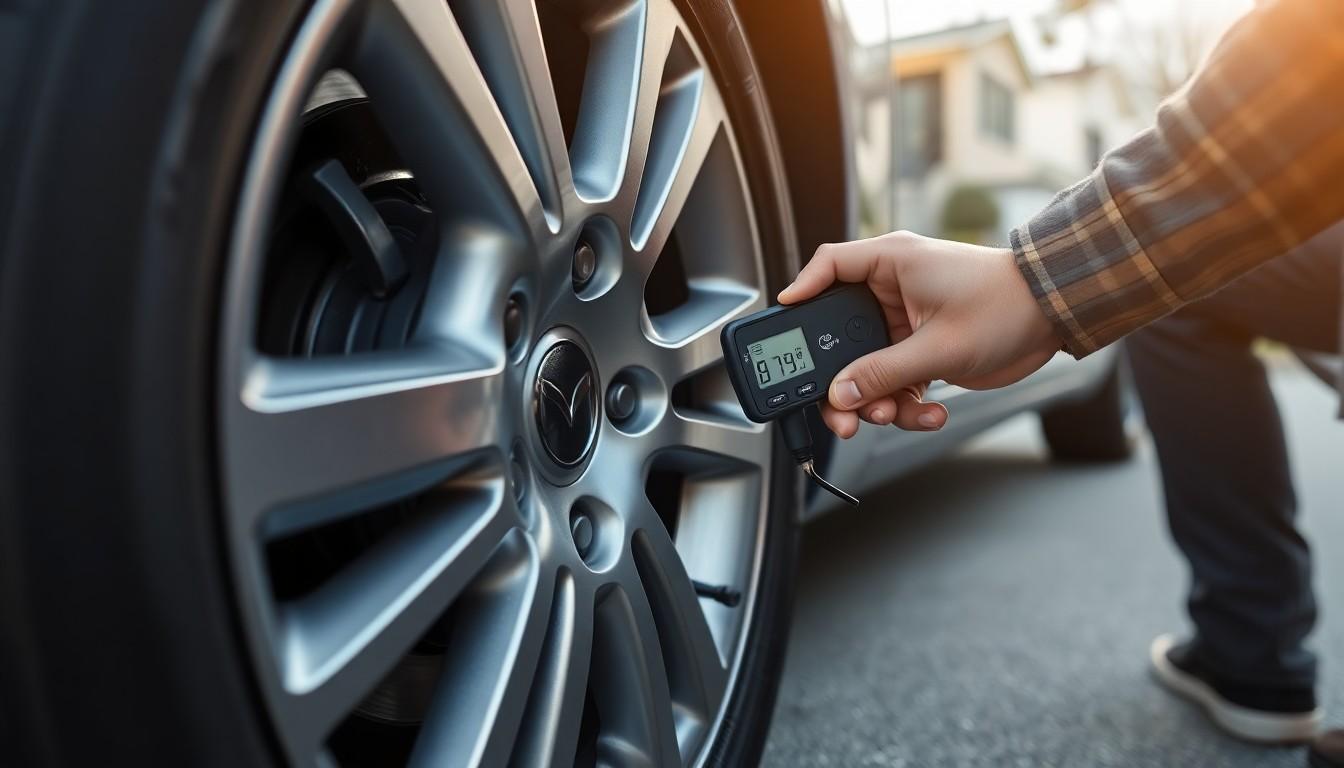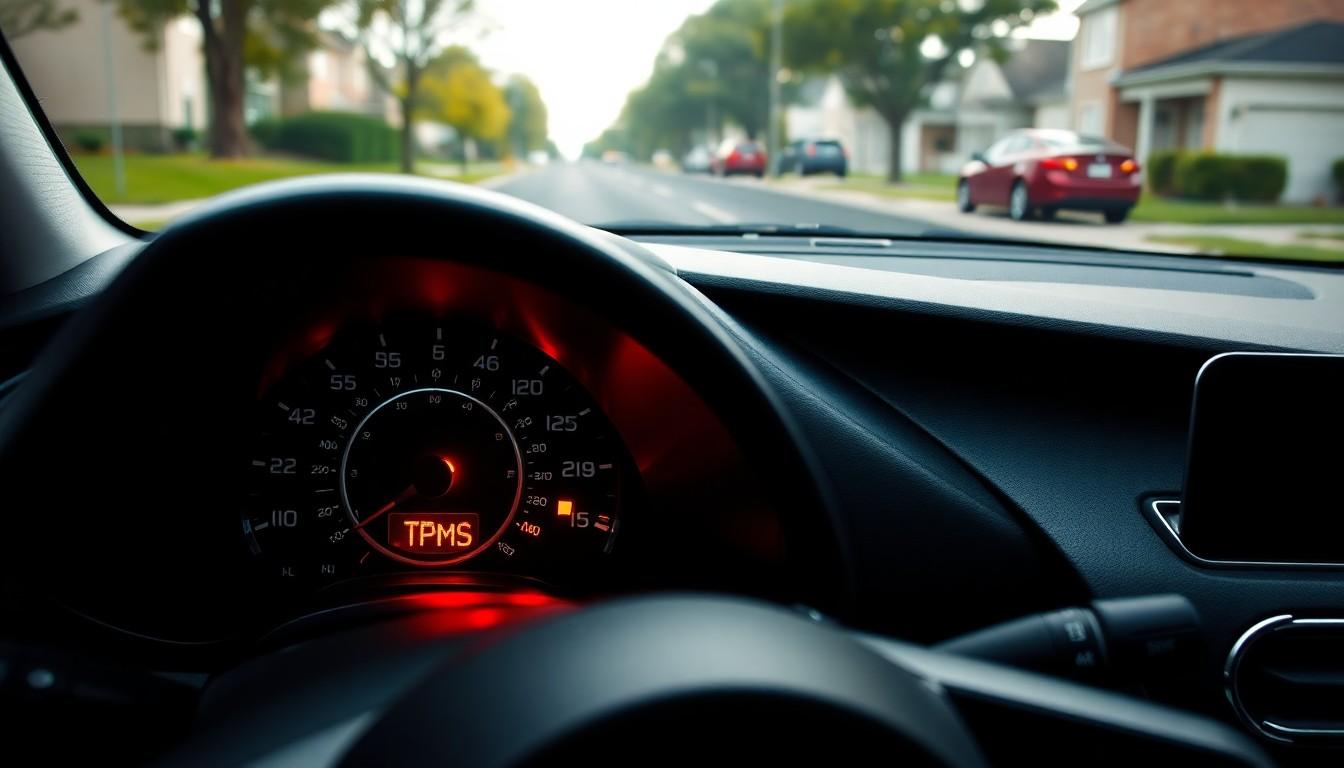Are you seeing that dreaded TPMS light on your Mazda 3 dashboard? We’ve all been there—it’s frustrating when warning lights appear, especially when your tires seem perfectly fine. The Tire Pressure Monitoring System (TPMS) is designed to keep you safe, but sometimes it needs a simple reset after tire rotations, pressure adjustments, or sensor replacements.
In this guide, we’ll walk you through the quick and easy process to reset your Mazda 3’s TPMS. Whether you’re driving a newer model with the push-button system or an older version that requires a different approach, we’ve got you covered. No need for expensive trips to the dealership when you can handle this maintenance task yourself in just minutes.
Understanding TPMS in Your Mazda 3
The Tire Pressure Monitoring System (TPMS) in your Mazda 3 serves as a critical safety feature that constantly monitors tire pressure levels. This advanced system alerts drivers when tire pressure drops below safe operating levels, helping to prevent accidents and improve overall vehicle performance.
How the Tire Pressure Monitoring System Works
Mazda 3’s TPMS uses electronic sensors mounted inside each tire to measure air pressure continuously. These sensors transmit real-time data to your vehicle’s computer system approximately every 30 seconds while driving. When tire pressure falls 25% below the manufacturer’s recommended level, the system triggers the warning light on your dashboard. Mazda implements two main types of TPMS: direct systems (found in newer models) that use physical pressure sensors in each tire, and indirect systems (in some older models) that calculate pressure differences through wheel rotation speeds via the ABS system. The system monitors all four tires independently, giving you comprehensive coverage for safety on the road.
Benefits of Proper Tire Pressure Maintenance
Maintaining correct tire pressure through your Mazda 3’s TPMS offers multiple important advantages for vehicle performance and safety. Properly inflated tires extend tire life by up to 20%, reducing uneven wear patterns that often lead to premature replacement. Fuel efficiency improves by approximately 3% when tires are properly inflated, saving you money at the pump over time. Safety enhancements include better traction, shorter stopping distances, and reduced risk of blowouts—especially during highway driving. Handling characteristics of your Mazda 3 remain optimal with correct tire pressure, giving you more responsive steering and stability during emergency maneuvers. Environmental benefits also emerge from proper tire maintenance, as correct inflation reduces rolling resistance, which lowers fuel consumption and decreases carbon emissions by an estimated 400-700 pounds of CO₂ annually for the average driver.
When to Reset Your Mazda 3 TPMS

The Tire Pressure Monitoring System (TPMS) in your Mazda 3 requires resetting in exact situations to ensure accurate readings. Understanding when to reset the system helps maintain optimal vehicle performance and safety.
After Tire Rotation or Replacement
Resetting your Mazda 3’s TPMS becomes necessary immediately after rotating or replacing your tires. This reset allows the system to recognize the new tire positions and sensor locations accurately. To properly reset the system post-rotation, drive your vehicle at a speed of at least 16 mph for 3 minutes or longer. During this drive, the TPMS effectively relearns the new configuration of tire sensors, ensuring each tire’s pressure displays correctly on your dashboard.
Following Pressure Adjustments
Your Mazda 3’s TPMS needs resetting after any tire pressure adjustments to clear warning lights and update the system. First, ensure all tires are inflated to the correct pressure as specified in your owner’s manual or on the tire information placard. Next, switch the ignition on, then turn it back to accessory mode or off completely. Allow at least 19 minutes for the system to complete its sensor signal processing. Once the waiting period ends, drive the vehicle at a minimum speed of 16 mph for 3 minutes or longer to finalize the reset process. For stubborn warning lights, turning the car completely off and then restarting it sometimes clears the TPMS warning. Unlike some vehicle models, Mazda 3s don’t feature a dedicated reset button for the TPMS system.
Step-by-Step Guide to Reset Mazda 3 TPMS

Resetting the Tire Pressure Monitoring System (TPMS) in your Mazda 3 varies depending on the model year and features. We’ve outlined the exact methods below for different Mazda 3 configurations to help you properly reset your TPMS system.
Method for Models with Push-Button Reset
Older Mazda 3 models sometimes include a dedicated TPMS reset button, though this feature isn’t common in newer vehicles. For these models, follow these straightforward steps:
- Park your vehicle in a safe location and engage the parking brake
- Ensure all tires are inflated to the manufacturer’s recommended pressure (found in your owner’s manual or driver’s door jamb)
- Locate the TPMS reset button on your dashboard or steering column
- Turn the ignition to the “ON” position without starting the engine
- Press and hold the reset button for approximately 2-3 seconds
- Release the button when you hear a confirmation beep or see the TPMS light flash
- The system resets once the light turns off completely
This method applies primarily to pre-2014 Mazda 3 models, as newer generations typically use alternative reset procedures.
Method for Models Using the Infotainment System
Most current Mazda 3 models don’t feature a dedicated reset button and instead rely on an automatic calibration process. Reset your TPMS by following these steps:
- Inflate all tires to the correct pressure according to the specifications on your driver’s side door jamb
- Turn the ignition to the “ON” position, then back to accessory mode or completely off
- Wait a minimum of 19 minutes for the system to initialize
- Drive your vehicle at speeds exceeding 16 mph for at least 3 minutes
- Monitor your dashboard for the TPMS light to turn off, indicating successful recalibration
The 2019 Mazda 3 and newer models feature an advanced TPMS that automatically recalibrates after tire pressure adjustments. These models display tire pressure information directly through the infotainment system, allowing you to monitor tire status without requiring manual resets in most situations.
Troubleshooting Common TPMS Reset Issues

Even after following the correct reset procedures, you might encounter issues with your Mazda 3’s TPMS system. Understanding these common problems and their answers can save you time and potentially expensive trips to the mechanic.
TPMS Light Stays On After Reset
The persistent illumination of the TPMS light after completing a reset procedure indicates several potential issues requiring attention. First, double-check that all tires are inflated to the recommended pressure levels found on the driver’s side doorjamb placard or in your owner’s manual. Correct pressure readings should clear the warning light after driving for a few minutes at speeds above 16 mph. Malfunctioning TPMS sensors often cause this problem, so inspect them for damage and replace if necessary. The system might also need reinitialization if the standard reset doesn’t work – let your tires cool completely, adjust the pressures to recommended levels, and drive the vehicle again to complete the process.
System Not Responding to Reset Procedure
When your Mazda 3’s TPMS system fails to respond to reset attempts, timing often plays a crucial role in the process. Ensure you’ve waited the full 19 minutes after switching the ignition on and off before starting to drive. Many reset failures occur because drivers don’t maintain the required speed of at least 16 mph for the minimum 3-minute duration needed for the system to recalibrate properly. Low battery levels in the TPMS sensors commonly prevent successful resets, so checking and replacing these batteries might solve your problem. For persistent issues that don’t respond to these troubleshooting steps, consulting your owner’s manual provides model-exact guidance, or visiting a Mazda dealership connects you with technicians experienced in diagnosing and fixing complex TPMS problems.
Maintaining Your Mazda 3 TPMS Long-Term

Regular maintenance of your Mazda 3’s Tire Pressure Monitoring System ensures optimal performance and extends the life of your tires. Proper tire pressure contributes significantly to fuel efficiency, handling, and safety on the road. Let’s explore essential practices to keep your TPMS functioning correctly for years to come.
Regular Pressure Checks
Checking your tire pressure consistently prevents TPMS warnings from appearing unexpectedly. Monthly inspections allow you to maintain the manufacturer-recommended pressure levels listed on your driver’s side doorjamb. Seasonal temperature changes affect tire pressure significantly, with pressure dropping approximately 1 PSI for every 10°F decrease in temperature.
Sensor Battery Life
TPMS sensors contain batteries that typically last 5-7 years before requiring replacement. Signs of failing sensor batteries include intermittent TPMS warnings or the system failing to reset properly after multiple attempts. Professional inspection during regular maintenance helps identify sensors nearing the end of their lifespan.
Professional System Inspection
Having your TPMS inspected during routine tire services prevents unexpected failures. Technicians can verify sensor functionality, check for physical damage, and ensure proper communication between sensors and the vehicle’s computer system. Many Mazda dealerships offer comprehensive TPMS diagnostics as part of their service packages.
Weather Considerations
Extreme temperature fluctuations impact tire pressure readings and TPMS performance. Cold mornings often trigger TPMS warnings that may disappear once tires warm up during driving. Checking pressure when tires are cold provides the most accurate readings and helps you adjust pressure appropriately for changing seasons.
Tire Rotations and TPMS
Performing a TPMS reset after every tire rotation maintains system accuracy. Driving at speeds over 16 mph for at least 3 minutes following a rotation allows the system to relearn sensor positions. This practice prevents false warnings and ensures the system correctly identifies which tire might be underinflated in the future.
Conclusion
Resetting your Mazda 3’s TPMS doesn’t have to be complicated. With our guide you can easily maintain this crucial safety system whether you have an older model with a reset button or a newer version with automatic calibration features.
Remember that proper tire pressure isn’t just about avoiding that annoying dashboard light. It directly impacts your vehicle’s safety performance fuel efficiency and tire longevity.
By understanding when and how to reset your TPMS and incorporating regular maintenance into your routine you’ll ensure optimal performance from your Mazda 3 for years to come. Take charge of your vehicle’s maintenance and drive with confidence knowing your tires are properly monitored.
Frequently Asked Questions
What is TPMS in a Mazda 3?
TPMS (Tire Pressure Monitoring System) is a safety feature in Mazda 3 vehicles that continuously monitors tire pressure levels. It uses electronic sensors in each tire to provide real-time data to your vehicle’s computer and triggers a warning light on your dashboard when pressure drops significantly below recommended levels.
Why does my Mazda 3 TPMS light come on?
Your Mazda 3’s TPMS light activates when tire pressure is approximately 25% below the recommended level. This can happen due to natural air pressure loss over time, temperature changes, small punctures, or after maintenance procedures like tire rotations or replacements when the system needs to be reset.
When should I reset the TPMS in my Mazda 3?
You should reset your Mazda 3’s TPMS after tire rotations, tire replacements, or pressure adjustments. Resetting ensures the system accurately recognizes new tire positions and pressure levels, clearing any warning lights and updating the system to maintain optimal vehicle performance and safety.
How do I reset TPMS on older Mazda 3 models?
For older Mazda 3 models with a dedicated reset button: Park your vehicle, inflate all tires to the recommended pressure (found on the driver’s door jamb), locate the TPMS reset button (usually under the dashboard or in the glove compartment), press and hold it until the TPMS light blinks twice, then drive for about 20 minutes to complete calibration.
How do I reset TPMS on newer Mazda 3 models?
Newer Mazda 3 models use automatic calibration. Inflate all tires to the recommended pressure, turn the ignition to ON position (engine off), navigate to vehicle settings in the infotainment system, select “TPMS Calibration” or similar option, and follow on-screen instructions. Then drive above 16 mph for 15-20 minutes to complete recalibration.
Why is my TPMS light still on after reset?
If your TPMS light remains on after reset, check that all tires (including spare) are properly inflated to recommended pressures. Ensure you followed the correct reset procedure for your specific model year. Temperature drops can cause pressure decreases. If the issue persists, a sensor may be damaged or have a dying battery requiring professional inspection.
How long do TPMS sensors last in a Mazda 3?
TPMS sensor batteries typically last 5-7 years in a Mazda 3. When batteries fail, sensors will need replacement. Signs of failing sensors include erratic TPMS light behavior or persistent warnings despite proper tire pressure. Consider proactive replacement during tire changes after the 5-year mark to prevent unexpected failures.
Can I drive with the TPMS light on?
You can drive with the TPMS light on, but it’s not recommended for extended periods. The light indicates at least one tire is significantly underinflated, which can lead to reduced fuel efficiency, premature tire wear, compromised handling, and increased blowout risk. Check your tire pressures as soon as possible and address the issue.
How often should I check my Mazda 3 tire pressure?
Check your Mazda 3’s tire pressure at least once a month and before long trips. Temperature changes significantly affect tire pressure (typically 1 PSI for every 10°F change). Always check pressure when tires are cold for accurate readings. Regular monitoring helps maintain optimal fuel efficiency, tire life, and vehicle safety.
Do 2019 and newer Mazda 3 models have different TPMS systems?
Yes. 2019 and newer Mazda 3 models feature an advanced TPMS that displays actual tire pressure information through the infotainment system. These newer systems often require less manual resetting as they can automatically recalibrate during normal driving. The reset process is typically performed through the infotainment system rather than a physical button.

